Campus Traditions Then and Now
a dusty dive into yellowing copies of ‘The Phoenix’ inspires a whimsical and vibrant jaunt through history
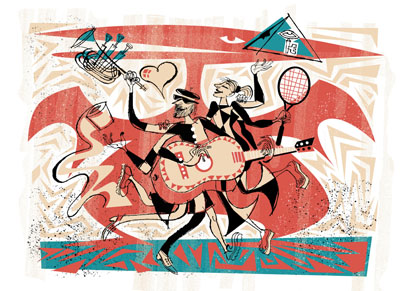
Book and Key Society
“I remember the induction of members of Book and Key, when a ghastly hand came out the door and pulled the new member in.”
—Andy Wilcox Palmer ’51
An eerie and windowless pyramid once stood at the end of Whittier Place on Elm Street. What happenedinside was unknown to all but seven senior men. This was Swarthmore’s secret Book and Key Society, which endured from 1906 to 1966. The club, founded by Morris L. Clothier, Class of 1890, and Howard Cooper Johnson, Class of 1896, was consciously modeled on secret societies at Yale.
The Temple, as the Egyptian-style clubhouse came to be known, was paid for by Clothier, and in 1906, the first seven “bookies” were initiated. Club members were known to get up from the dining hall at seven minutes to 7 each Thursday night to begin a silent, strange procession to the Temple for their weekly meeting. Each spring, seven juniors were selected by outgoing members during “tap night,” on the first Thursday of May. According to an Oct. 8, 1957, Phoenix article, the entire student body would gather in front of Parrish to observe, while every seven minutes a Book and Key member would rush into the crowd and tap a junior until seven had been selected. Selection seems to have been based on each man’s other campus leadership positions: members were usually captains of sports teams, student council members, or fraternity officers. Masses gathered a week later in front of the Temple to watch as initiates lined up.
“A crashing of chains, a rumbling of gears, and the door would inch open,” says the 1957 Phoenix article. “A grotesque white hand would reach out and snatch [a new member] into the Temple.”
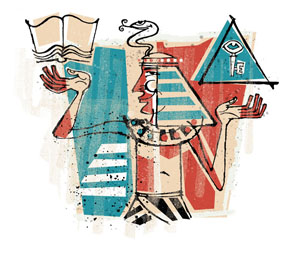
Once inside, initiation rites were arcane spectacles, with ornate handshakes and oaths recited from memory. Blindfolded throughout the initiation, Ed Mahler ’50 remembers the ominous sound of running water in The Temple and then staying up all night to ring a gong at the top of the building every hour.
The accelerated wartime program at the College and the proliferation of veterans after World War II dealt the club a blow from which it never recovered. Soon, enthusiasm for membership and the closely held secrecy waned, opening the organization to fierce scrutiny. With an ever-more-unified student body, tap night and elaborate initiations long gone, the club struggled to attract membership. No new members were tapped in 1957, much to the chagrin of the Temple Trust Association, composed of mostly “bookie” alumni. The group stagnated for nearly 10 years before selling the clubhouse to Swarthmore for $1 and donating its remaining assets to the College. The building, windowless and out of code, was razed in 1967 leaving behind the empty lot that remains to this day.
The Marching Band
“Some of my fondest memories are of the small marching band we had—some 28 marchers. At the Haverford game my freshman year, we were determined to be on TV, so with the players all lined up and ready to go, down the muddy field we came—I even temporarily lost a shoe.”
—Barbara Hill Lindsay ’54
Swarthmore’s marching band was remembered by Bill Hirsch ’49 as a ragtag team of shoeless musicians with a sprinkling of stringed instruments among their ranks. An email to his class quickly set the record straight: Memories poured forth of organized—and yes, shoed—musicians adroitly providing all the necessary Sousa selections to back up the Garnet on the gridiron.
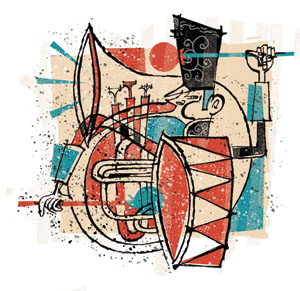 The first of the marching bands on campus began in 1928, according to the 1929 Halcyon. By 1929, the band had “improved greatly,” and garnet cloaks and berets were purchased. However, by Ken Hechler ’35’s freshman year in 1931, the band was again nonexistent, so he was permitted to write all incoming men in the Class of 1937 to bring their instruments if they were musicians.
The first of the marching bands on campus began in 1928, according to the 1929 Halcyon. By 1929, the band had “improved greatly,” and garnet cloaks and berets were purchased. However, by Ken Hechler ’35’s freshman year in 1931, the band was again nonexistent, so he was permitted to write all incoming men in the Class of 1937 to bring their instruments if they were musicians.
“Dean of Women Frances Blanchard eyed me coldly as though I was a sex maniac,” Hechler wrote in a May 1993 Bulletin article of his attempts to include incoming females in his campaign. “I resisted the strong temptation to observe that I was only a sax maniac.”
And so it was that in Depression-era Swarthmore, Hechler created the Garnet Marching Band, a tradition that is much mentioned by its members in Swarthmore reunion yearbooks from classes in the next three decades.
By the mid–’70s, however, the band, then called the Swarthmore Marching Society, had become the College’s version of a “scramble band,” a movement popular in Ivy League schools in the ’60s, which rebelled against the regimented formation of traditional marching bands, Jim Rupert ’79 recalls. Instead of marching, students performed music to wacky skits at halftime and, according to Rupert, “once ran formations to illustrate a sperm fertilizing an egg.”
Not surprisingly, the football players, trying to recover from what was then the longest losing streak in American collegiate sports (36 straight games), did not appreciate any additional follies on the field, Rupert says; by 1976 the band was being budgeted a scant $150 per year, according to The Phoenix. Tom Lapinski began his tenure as coach in the late ’70s, turning the team around and bringing Swarthmore into the national rankings by the early ’80s. By then there was no band to herald the victory.
The Folk Festival
“Dress styles … were tame compared to what was soon to come, but there was enough informality [at Swarthmore’s Folk Festival] to arouse negative reactions. Most notably, many of the young visitors, both male and female, wore blue jeans.”
—Ralph Lee Smith ’51, “If I Had a Song,” the Bulletin, March 1997
Swarthmore students’ love for music found its official footing in February 1940 when a women’s physical-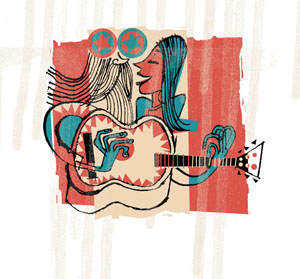 education teacher organized a barn dance on campus. The wild popularity of the event gave way to weekly instructional classes on leading and teaching square and folk dancing, which would satisfy the phys ed requirement. Enthusiastically, that class had a mission to create a music festival for campus, which led to the first Folk Festival in May 1945 featuring Richard Dyer-Bennet.
education teacher organized a barn dance on campus. The wild popularity of the event gave way to weekly instructional classes on leading and teaching square and folk dancing, which would satisfy the phys ed requirement. Enthusiastically, that class had a mission to create a music festival for campus, which led to the first Folk Festival in May 1945 featuring Richard Dyer-Bennet.
In the next decade, the event and the renown of the performers grew exponentially, featuring acts like Leadbelly, Woody Guthrie, Pete Seeger, and Jean Ritchie. By 1955, attendance exceeded 2,700, and while the audience was never unruly, having so many campus visitors—outnumbering the student body by a ratio of 3-to-1—did not sit well with campus officials. Facilities were inadequate for such large crowds, and administrators couldn’t square the notion of campus resources being devoted to the enjoyment of more outsiders than students. It was decided no Folk Festival would occur in 1956 to allow time to study the issue. Students, irate at not being given representation on the committee formed to examine the festival, were eventually given three places on the committee. Despite their efforts to limit attendance, there was no festival.
The Folk Festival began again in 1957 and was smaller, with specifications agreed upon by students and administrators. While the ensuing folk festivals were widely enjoyed, the yearly tradition came to a halt in 1964, giving rise to sporadic folk festivals throughout the ’70s and then to the campus’ comparatively short-lived Rock Festival.
Today, students continue the Swarthmore passion for communal music through the Large Scale Event, a springtime concert featuring big names in pop and hip-hop, which in recent years has been large enough to warrant use of the field house. Worthstock, an all-day outdoor music event, is a kielbasa-based picnic featuring local acts on the day after spring classes adjourn.
Of Curfews and Kleenex Boxes
“Open house was in both boys’ and girls’ dorms on Sunday afternoons. The door had to be open 6 inches (the width of a Kleenex box), and everyone had to have one foot on the floor at all times.”
—Pat Myers Westine ’61
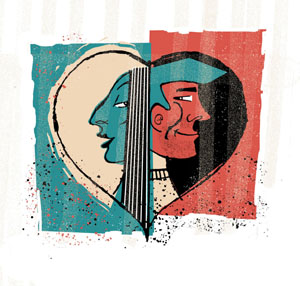 Swarthmore’s second president, Edward Magill, infamously banned the two sexes from walking the grounds together or “coasting upon the same sled,” in his “100 rules” in 1883. Throughout the ensuing 90 years, the comingling of the sexes created consternation for administrators and students. By today’s standards, the bygone parietals established for dorm life seem archaic—and even amusing—but for several decades, these rules dictated much of campus and student life.
Swarthmore’s second president, Edward Magill, infamously banned the two sexes from walking the grounds together or “coasting upon the same sled,” in his “100 rules” in 1883. Throughout the ensuing 90 years, the comingling of the sexes created consternation for administrators and students. By today’s standards, the bygone parietals established for dorm life seem archaic—and even amusing—but for several decades, these rules dictated much of campus and student life.
Students would not receive full autonomy over their nightly comings and goings until 1970—a long and uphill battle for students—but in the preceding decades, strict attention was given to male-female relations. Verdi Hoag Johnson ’45 recalls the institution of open houses (weekend afternoon hours during which men could visit female students’ rooms—doors open, of course), which were heralded with great fanfare, including formal invitations and refreshments. Patricia Clark Kenschaft ’61 recalls one man’s expulsion after being discovered playing cards with women in their dorm room after curfew. Yet, in the ’60s, the rules were somewhat relaxed, allowing for once-monthly “3-o’clocks,” which permitted an elongated curfew. All women were escorted by their dates back to the dorm for sign-in, their goodbyes supervised by a stern Agnes, a woman who oversaw nightly sign-ins, according to Pat Myers Westine ’61.
Kenschaft explains the stark contrast of modern coed dorm life in a memory of visiting her daughter, Lori Kenschaft ’87. A knock came on her daughter’s door as mother and daughter readied for bed, Pat’s cue to modestly hide under her covers. She watched as Lori, “much more scantily dressed,” opened the door: It was a man! He asked to borrow a cake pan, which Lori produced. “That’s some outfit for greeting male guests,” Pat said once the door was safely closed. (The “scanty” outfit, adds Lori, was a plain summer nightgown—a gift from her mother.)
On-Campus Cuisine
“I waited tables at the druggie [Michael’s College Pharmacy] on Sunday morning so I could have bacon sandwiches and grilled cinnamon buns. I remember the term ‘mystery meatballs’ used in the campus dining hall; we joked about what it actually was, because meat was rationed.”
—Verdi Hoag Johnson ’45
So overextended were the old dining facilities in Parrish, that President Courtney Smith once called it “a struggle for survival,” and the Bulletin proclaimed Sharples as “a humane setting,” upon its opening in 1964. Overrun or otherwise, the 400-seat Parrish dining facilities and its fare are remembered often, not always fondly, by alumni in reunion yearbooks and class notes. Many recall butter pats flung at the dining-hall ceiling, and others remember a well-loved game of removing a coffee-cup-and-saucer pair from amid a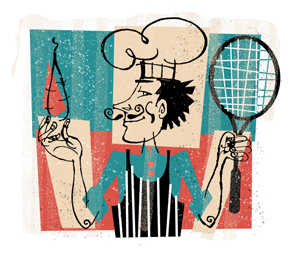 stack of four without toppling the pairs above or below.
stack of four without toppling the pairs above or below.
“Subbies,” as hoagies were once called on campus, were outsourced from various off-campus locales, and sold black-market style on dorm floors. “An enterprising student would take orders, go all the way to Chester on the bus, and bring back the most wonderful smelly meats-onion-cheeses subby sandwiches,” Betty Chase Odum ’47 wrote in her reunion yearbook. Other off-campus favorites included the druggie (the local pharmacy) and the Ingleneuk Café, where students held jobs for spending money, and also for the free eats.
The “served meal” in Sharples in the ’70s is one indication that the College food was meeting muster. Students could sign up to serve their peers who would make reservations and dine with extra formality in a smaller dining room in Sharples, which back then served steak on Saturdays.
By the ’90s, on-campus eats had evolved from mundane to gourmet, and among an ever-growing foodie culture throughout America, Paces cooks and bakers were born.
“It was almost a competitive sport,” says Lani Seidel Horn ’93 recounting that their complicated recipes required trips to various Philadelphia markets. Twice a semester, Paces cooks, who normally made lighter nighttime fare, would battle shoddy equipment to turn out a Sunday brunch. The chefs competed with gladiator-like intensity. Burners were either on or off—Horn describes maneuvering pans above the flames to adjust temperatures—making brunches “our personal Wimbledon,” she writes. Almost Sampras-like in the kitchen, John Krinsky ’91 once received a comment card praising him for the salmon quiche Horn had created. She burst into tears as Krinsky, having planted the card, broke into laughter. “I saved that card with my recipes to remind myself that cooking should not be about the ego,” says Horn.
Today, students seem to be generally satisfied with Sharples fare, though delivery from local pizzerias or Chinese-food restaurants is common. Eateries on Baltimore Pike, such as Panera or Qdoba, also draw students—if they can get there.
“If you know someone with a car and they’re going out to eat,” says Bulletin intern David Fialkow ’15, “you do whatever you can to get in that car.”
The McCabe Mile
“You can hear the muted thunder of running until it’s over. Then sweaty students come up the stairs, two of whom have huge rolls of toilet paper … ”
—Mary Ann Wood, McCabe librarian
Peter Koelle ’79 described it as a “combination of the Boston Marathon and the Indie 500” in a 1989 Philadelphia Inquirer story; others have likened it to a roller derby on feet. The McCabe Mile, started in 1970 by Dave Johnson ’73 and Peter Gould ’73, still endures, along with its various rites. Fatigued and stir crazy in their McCabe basement carrels, Gould and Johnson concocted a plan to stage a race consisting of 18 laps around the stacks.
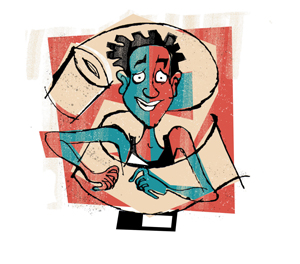 The event quickly gained momentum: as participation escalated, contestants were arranged by class year—freshmen, then freshmen who ran cross-country or track, and so on, ending with seniors. Johnson, who presided over many races after graduation, once found time beforehand to browse the stacks, coming across an inspiring quote. While reading it to the queued-up runners, someone in the back blurted out the source. Johnson says he pronounced the boy a “true scholar” and told the throng to make way, moving him to the head of the line. Today, a runner who can cite a quote’s source enjoys the same advancement. The book is then slapped shut to begin the race. Amid the brutal 90-degree turns and the jostling runners, the stacks loom, teeming with students who straddle and stand on or between the bookshelves, cheering.
The event quickly gained momentum: as participation escalated, contestants were arranged by class year—freshmen, then freshmen who ran cross-country or track, and so on, ending with seniors. Johnson, who presided over many races after graduation, once found time beforehand to browse the stacks, coming across an inspiring quote. While reading it to the queued-up runners, someone in the back blurted out the source. Johnson says he pronounced the boy a “true scholar” and told the throng to make way, moving him to the head of the line. Today, a runner who can cite a quote’s source enjoys the same advancement. The book is then slapped shut to begin the race. Amid the brutal 90-degree turns and the jostling runners, the stacks loom, teeming with students who straddle and stand on or between the bookshelves, cheering.
The two lead runners are awarded a roll of toilet paper each, in honor of Thomas McCabe, Class of 1915, the library’s namesake and former president of the Scott Paper Co. The race still occurs—always with little publicity—typically at night during Ride the Tide weekend in April for Swarthmore’s newly admitted students, who watch in awe.
Pterodactyl Hunt
“I remember one year, a few students from Bryn Mawr and Haverford were on campus during the hunt and had no idea what was happening. They ended up running through the woods to avoid getting hit by the foam bats.”
—Mark Dlugash ’08
Swarthmore is probably the only campus in the world with an orc-hobgoblin rivalry. These are but two from a long list of monsters that pterodactyl hunters will encounter on their quest for the ultimate prize: pizza.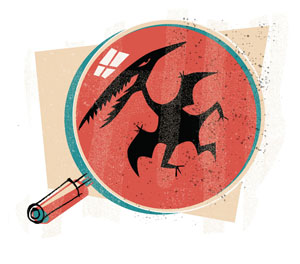
The Pteradactyl Hunt, originally a joke within the Folk Dance Club, has been held yearly since 1982. In 1984, the event, which includes donning trash bags as armor and wielding foam bats as swords, was taken over by SWIL (Swarthmore Warders of Imaginative Literature), now known as Psi Phi, the science fiction and fantasy club. The tradition grew, both in the number of participants and the intricacy of its rules.
“We spent endless hours on weekends buying pool noodles, duct tape, and cable ties to hand wrap the handles of lots and lots of foam swords,” writes Jillian Waldman ’06, who signed her email as “SWIL loremistress, former president, and duly elected Akon of Swat.” In her ’dactyl days, she was also known as a wizard, then an oracle, and finally, the elusive pterodactyl.
Today the hunt calls for three ’dactyls—each of which are protected by three orc guards—which cannot be battled without hunting licenses, bought with spoils from killing monsters. Last year the playing field engulfed the lower half of Parrish Beach from Sharples to the outdoor tennis courts. Once a team of hunters purchases a license, they can engage a pterodactyl, which is armed with a water gun, sporting a pair of huge PVC-supported cardboard wings to which targets are attached, and—probably—blue jeans. Once the targets have been knocked from each wing, the hunters can try to land a direct blow to the ’dactyl’s “armor” with their “swords.” If they successfully manage this, the prehistoric bird must relinquish its heart, which the victors use to redeem their delicious spoils.
“[SWIL] was a group of friends that practiced radical acceptance—the first place where people thought I was awesome because of my eccentricities,” says Waldman, who maintains friendships with enough fellow SWILlies that she had plenty of places to stay during a recent cross-country road trip. “I learned to be accepted and accept and nurture others [through SWIL], and the club was a huge part of what made Swarthmore wonderful for me.”
 Email This Page
Email This Page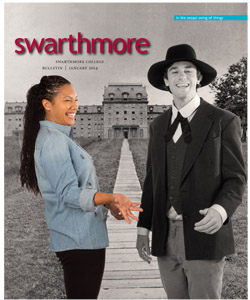
January 26th, 2014 6:22 pm
Re; Of Curfews and Kleenex Boxes When I was a student during the late 40ies the rules were very liberal. (Unfortunately they didn't change with the times and became very conservative later on) We could stay out until 10:15 PM and, if one signed out, until 12:30.AM. One time I and about 3 others had not signed out and missed the 10:15 deadline. So we just stayed out all night, slept in the car, and returned about 7AM.. As far as I know no one other than my roommate knew about that escapade.
Another rule that was liberalized in 1947 was about students getting married. The rule had been that if two students got married, one of them had to refrain from returning to Swarthmore, In deference to the returning vets, it was changed so that both students could return to Swarthmore. I was one of those who took advantage of that. Richard Cordray and I were married on June 21, 1947 and both of us were able to return in the fall of 1947. However, three conditions had to be met: 1. one of the couple had to be at least 22 years old, 2. both sets of parents had to write letters expressing their approval, and 3. the president of the College (then John Nason) had to give his approval after interviewing the couple. We passed and both of us graduated from Swarthmore. Arden Pierce '49